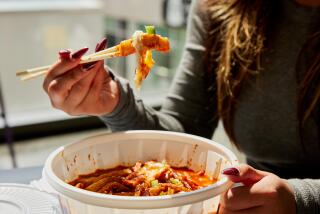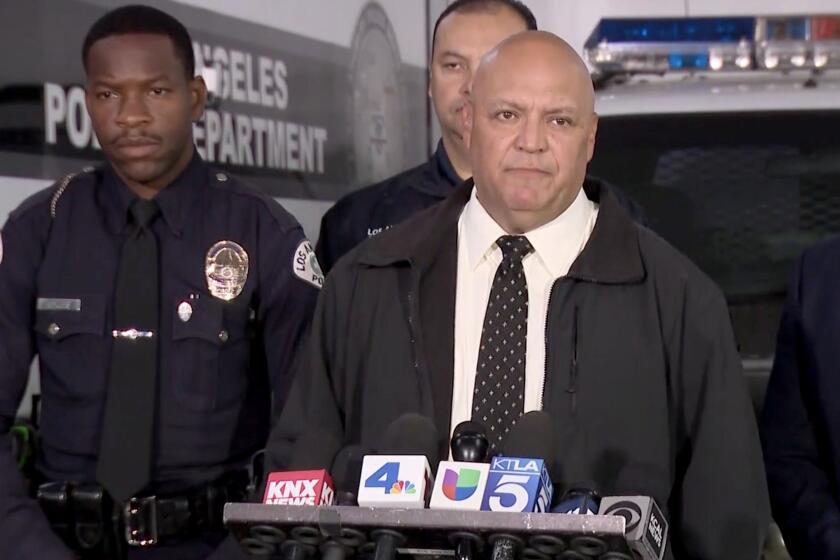Once a scene of clubbing and karaoke, this big purple building in Koreatown is being transformed
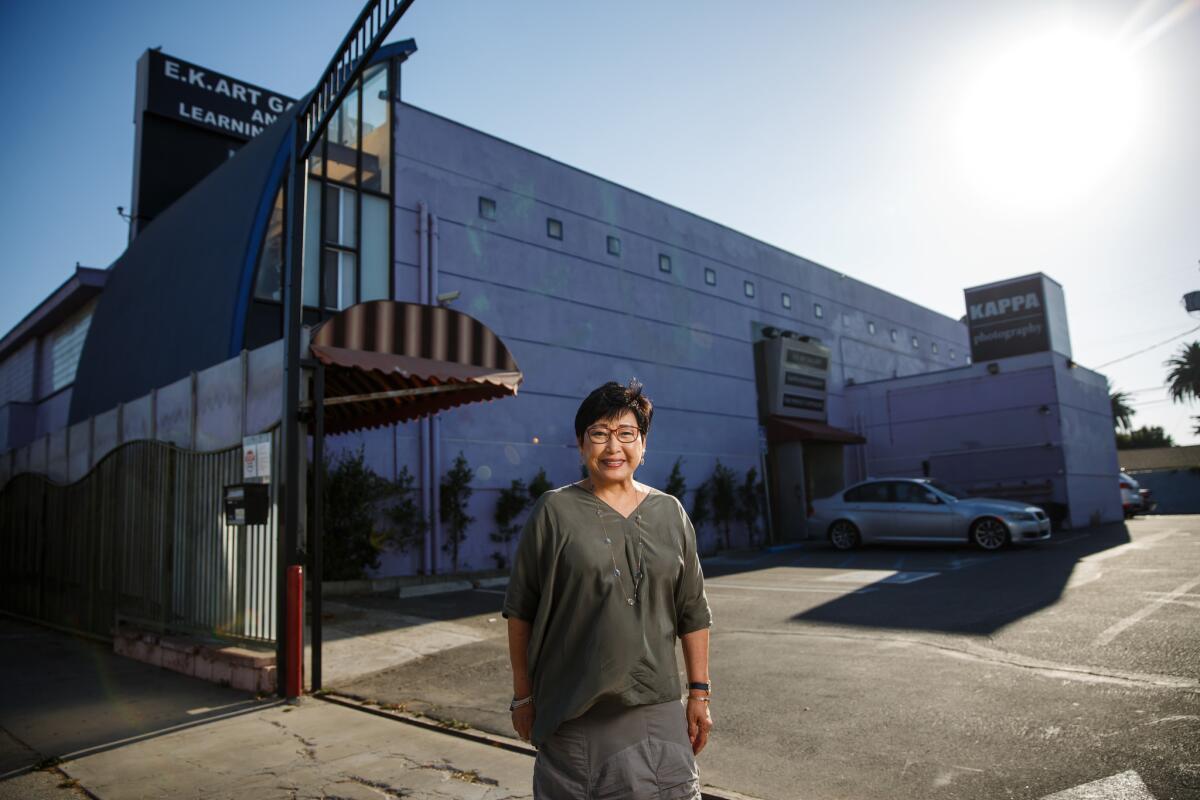
Along an otherwise vanilla stretch of Crenshaw Boulevard, the two-story Jetsons-esque building has always been hard to miss.
For starters, it’s purple.
It’s also a big commercial structure on a part of the thoroughfare where many buildings are residential.
And until recently, it was topped with a large sign bearing an obscure name: “Dooballo.”
For decades, the building at 1125 Crenshaw Blvd. was a mystery to the non-Korean neighbors who strolled, jogged and drove past. By night, fancy cars came and went, and when the glass double doors swung open, garish Korean dance music, popular with a middle-aged crowd, escaped.
Karaoke bars and a nightclub had moved into a building that once housed a mail-order vitamin business, and eventually many of those private rooms operated as “room salons,” or escort bars where hostesses pour drinks and keep men company while they drink.
By the time Officer Hebel Rodriguez of the Los Angeles Police Department’s Wilshire Division barged into the building during a vice raid in the mid-2000s, it was the type of establishment where a dozen young women in short dresses fled out the back — “obviously b-girls,” he said.
Dooballo — which translates as “on two feet” — embodied the ethos of Koreatown in its early days: It was owned and run by Koreans, for Koreans. No outsiders need come calling.
A couple of years ago, Eunice Kim heard that Dooballo’s owners were tired of the nightlife business and wanted to sell. A successful fashion designer and businesswoman, she’d become interested in photography while traveling for work and felt saddened that her fellow immigrants rarely had time to appreciate the arts, she said.
She bought the building and the adjacent parking lot in late 2015 for $7.5 million.
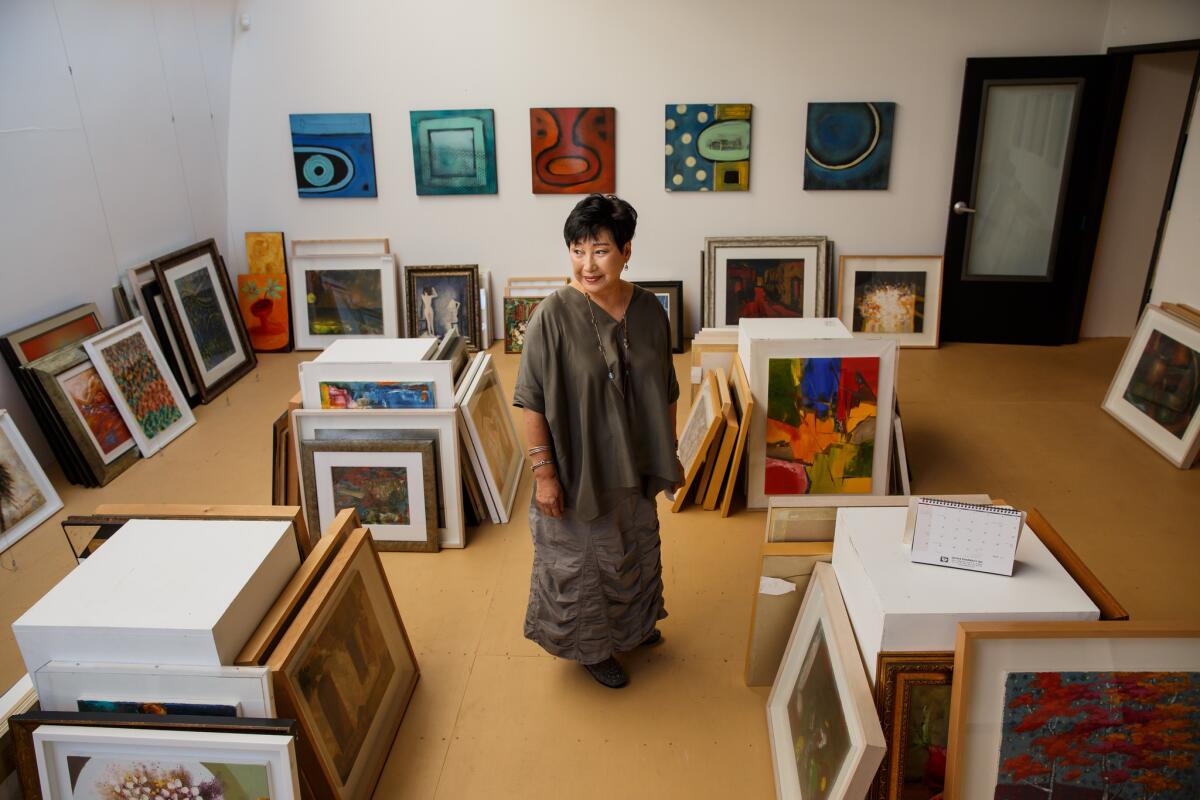
Now Kim says she wants to turn the building into an artistic and cultural hub and throw open its doors, bringing together the neighborhood’s diverse residents.
“Everyone just wants to build apartments; there’s no cultural development,” said Kim, now 75. For her generation of immigrants, she said, “We were busy working and going to school, we had no time to think about cultural experiences.”
Kim’s plan is to raze the purple building and rebuild a four-story structure to house a mix of classroom space, galleries and a ground-floor restaurant.
In the meantime, she has invited a photo gallery priced out of another part of Koreatown to take up temporary residence and had a friend, a fine-art dealer, move her sizable art collection into a second-floor gallery in the building.
Everyone just wants to build apartments; there’s no cultural development.
— Eunice Kim, the building’s new owner
Neighbors have met Kim’s vision with a mix of welcome and skepticism.
“The idea seems so nebulous,” said Judy Jeanson, who has lived nearby for a decade. She wonders how it will be profitable, and she wonders about Kim’s notion of “giving back to the community.”
“Why anyone would think they need to give back to Crenshaw, I have no idea,” Jeanson said.
But Mario Morales, who has lived two streets away since 1986, has started frequenting the gallery, where he’s helped with exhibitions and gained an appreciation for photography.
“I fell in love with it,” he said. “I’ve met a lot of nice people, and I found an artistic nature that I never knew I had.”
Dooballo opened in 1987 as a modest 50-seat restaurant at a time when outsiders were first noticing Koreatown as a rapidly growing commercial center. The restaurant, by all accounts, wasn’t interested in welcoming or catering to non-Koreans, and the feeling was mutual.
Why anyone would think they need to give back to Crenshaw, I have no idea.
— Judy Jeanson, who lives near the purple building
Nearby residents were wary of the newly ubiquitous Korean signage encroaching on their neighborhoods.
A Country Club Park neighborhood association president told The Times in 1988 that said residents fought and won a city regulation requiring commercial signs in their neighborhood to be larger in English than in other languages — unlike in neighboring Koreatown, where the streets were increasingly lined with Korean-language signage. “We didn’t want our area to be confused with Koreatown,” he said.
Dooballo wasn’t exactly reaching out to bridge the cultural gap.
Morales ran past the building every morning but never ventured into the club.
“I figured there must’ve been a lot of crazy stuff going on,” he said.
“It wasn’t one of those things where people said, ‘I’m really glad Dooballo is there,’” said Chris Elwell, president of the Oxford Square Neighborhood Assn., who has worked for years to get the streets abutting the building designated for historic preservation.
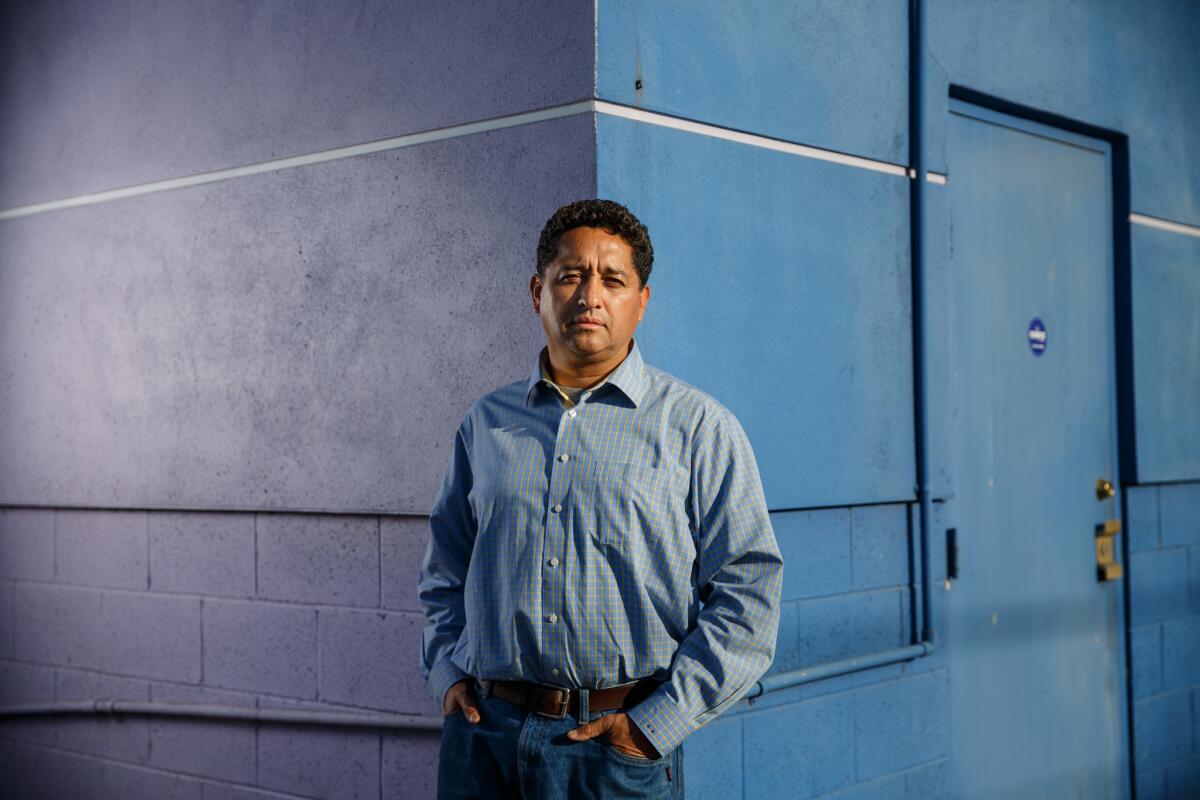
In August, Kim walked into photographer Armando Arorizo’s gallery on 6th Street in Koreatown. She told him about the cavernous, if eccentrically colored, vacant structure as the application for the new building was slowly slogging through the city’s approval process, and asked if he would be interested in taking up residence.
That same day, Arorizo, a veteran news photographer who worked for The Times in the 1990s, had received an eviction notice from the gallery space he’d been occupying for 25 years. He took it as a sign.
It wasn’t one of those things where people said, ‘I’m really glad Dooballo is there.’
— Chris Elwell, president of the Oxford Square Neighborhood Assn.
A few days later, Arorizo walked through an entry hallway painted entirely pink, then into a lobby with electric blue walls and thick carpet reeking of years of cigarette smoke. He counted 67 karaoke rooms — the building was last approved for 42 in 2013 — each with gaudy flower-print wallpaper and red and gold velvet upholstery.
He got to work, tearing out the malodorous carpet, knocking down walls and painting the remaining ones white, transforming the former nightclub into the Perfect Exposure Gallery, a sun-filled, spacious venue with a grand piano.
He painted over graffiti on the outside and took down barbed wire atop the external walls, leaving the exterior purple for now.
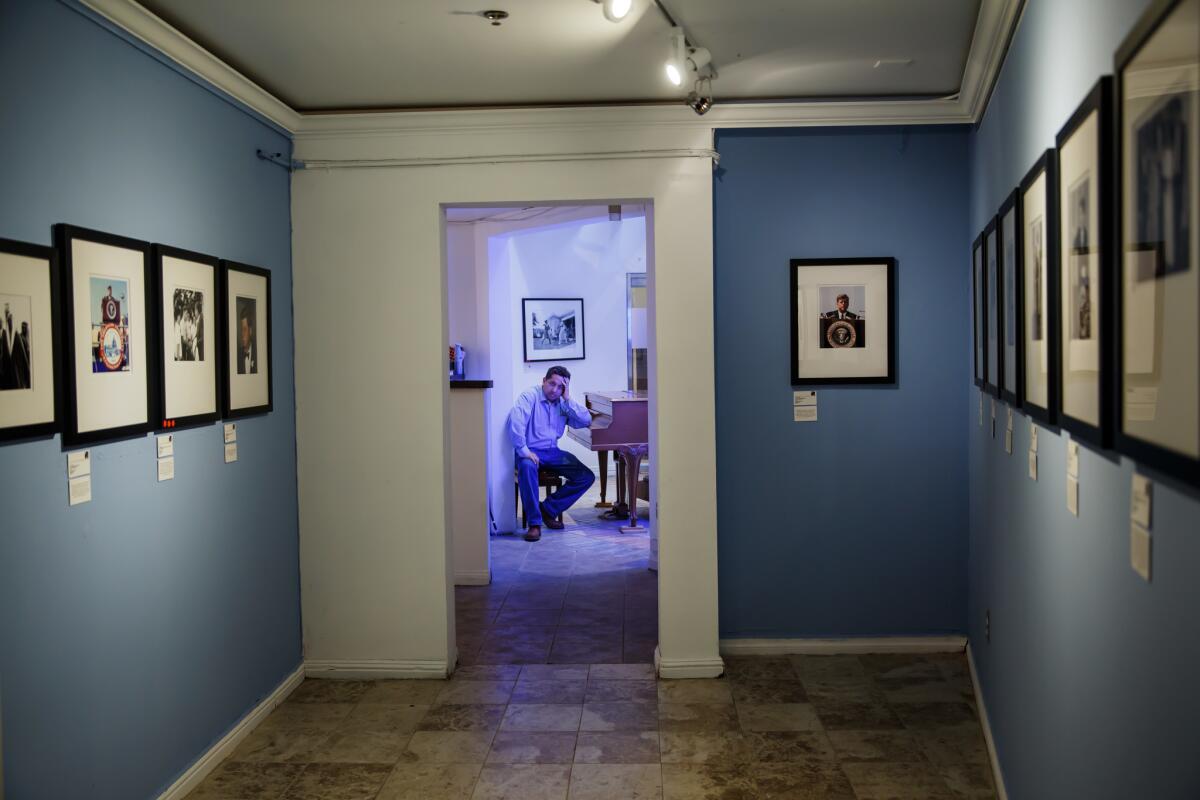
“The whole thing just blows my mind,” said John Simmons, a cinematographer and photographer who has work space in the gallery. “It’s what every artist wants, a space where you can be creative. It’s so multicultural.”
Arorizo sent out fliers and went door to door, inviting neighbors to the first exhibit at the end of last year for a group show of 75 photographers.
I figured there must’ve been a lot of crazy stuff going on.
— Mario Morales, who lives in the neighborhood
Since then, the gallery has held exhibitions on Cuba, actor Edward James Olmos, former President John F. Kennedy and the works of Pulitzer Prize-winning photographer Nick Ut.
Construction for the new building is tentatively scheduled for 2018.
Elwell, the neighborhood association president, said he’s reserving judgment.
“We’d love to see something great go into that space,” he said. “Something the neighbors like, and that knits both sides of Crenshaw together.”
For more California news, follow me on Twitter @vicjkim
More to Read
Start your day right
Sign up for Essential California for news, features and recommendations from the L.A. Times and beyond in your inbox six days a week.
You may occasionally receive promotional content from the Los Angeles Times.

